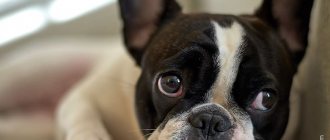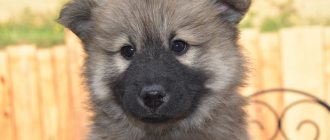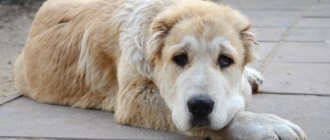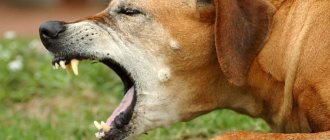Diseases and recommendations for the German Shepherd is an excellent family and guard dog. Thanks to its natural instincts, it perfectly guards and protects. She lends herself well to Schutzhund (a German training system aimed at preparing dogs of any breed for service in the police and similar institutions). Shepherds are used as search and rescue dogs and also as therapy dogs. Diseases of the German Shepherd are typical of those that affect large breeds of dogs, for example, hip and elbow dysplasia, tympanitis.
The most common diseases of the German Shepherd
German Shepherd Disease - Hip Dysplasia
— Elbow dysplasia
-German Shepherd disease Tympanitis
— Pararectal fistula
German Shepherd Disease Osteomyelitis We recommend osteomyelitis in dogs
German Shepherd disease Degenerative myelopathy we recommend degenerative myelopathy in dogs
— von Willebrand's disease
Hip dysplasia in the German Shepherd
Hip dysplasia affects many dogs, with more than 30% of German Shepherds suffering from the condition. Basically, this disease is considered hereditary, but factors such as poor diet and obesity can provoke it. The condition can range from mild hip pathology to severe joint displacement. To prevent and restore the normal condition of bones and joints, a natural diet in combination with WOLMAR WINSOME® PRO BIO GA-GLICAN and WOLMAR WINSOME® COLLAGEN MCHC is necessary
Elbow dysplasia in a German Shepherd
Osteochondritis (or dysplasia) of the elbow joint is a hereditary disease, but can also occur as a result of poor nutrition, damage, or injury. It is a deformity of the elbow joints of the forelegs due to different growth rates of the three bones that form the elbow. German Shepherds suffering from this condition usually have an obvious lameness. When walking, the shepherd dog stretches out its paw or even tries to completely lift its leg, removing the load from it. Signs of the disease in a German Shepherd are visible as early as 4 months of age. Elbow dysplasia in Shepherds is a lifelong condition, although some dogs may benefit from surgery to completely eliminate the problem.
Glycogenosis
Glycogenosis is a pathology from the group of autosomal recessive diseases, characterized by impaired glycogen metabolism.
It is known that the monosaccharide glucose is the main source of energy for life. Excess glucose is converted into glycogen polysaccharide granules, which are “energy stores” and deposited in the cytoplasm of liver and muscle cells.
Accordingly, when blood glucose levels drop, glycogen is again broken down into its components. If such a complex process of sugar transformation, triggered by several enzymes, is distorted, then excessive accumulation of glycogen occurs in the form of abnormal granules and disruption of the constancy of glucose levels in the blood.
The symptoms of glycogenosis are different and manifest themselves depending on the deficiency of a particular enzyme. German shepherds are characterized by breed-specific type III of the disease, characterized by a deficiency of the glycogen debranching enzyme. Experts call this pathology “Measles disease.”
The condition of young animals is not impaired, but by adulthood, glycogen reserves are increasingly replenished, manifested by muscle pain, decreased activity, lethargy, exercise intolerance and reduced blood glucose levels. Some older German Shepherds develop skeletal myopathy, cardiomyopathy, and cirrhosis of the liver.
Tympanitis in a German Shepherd
Tympanitis, or scientifically gastrectasia and volvulus, is a serious emergency disease in which a rapid accumulation of gas occurs in the stomach (gastrectasia). Sometimes, the gas-filled stomach becomes twisted (actually, a torsion), which can completely block the flow of blood into the stomach. As you can imagine, both gastrectasis and volvulus are critical German Shepherd emergencies that require immediate veterinary attention. Large breeds of dogs with a wide chest, like the German Shepherd, are more prone to tympanitis. Symptoms of the disease:
— The upper abdominal plane of a shepherd dog becomes swollen (like a tight drum)
- Excessive drooling, most likely due to pain.
- Labored breathing
- Inability to vomit (the shepherd may frantically eat grass to reduce the urge to vomit)
- Vomiting, belching
- Restless excited state
- Fast shallow breathing
- Gums become bluish or brown (critical condition)
Character
German Shepherds are smart, confident, fearless and know the limits of their territory. Any aggression directed towards the owner or other family members will be regarded by them as a signal to attack the offender. The dog will protect the people she loves to the last drop of blood. However, being well developed physically, she has every chance of defeating attackers.
Adults are distinguished by a calm and balanced character and can be trained much faster than representatives of other service breeds. It is no coincidence that they are actively used in the army and police.
At a young age, a dog may show disobedience and an attempt to dominate, but with proper training and moderate methods of physical influence, these qualities can be easily suppressed. The dog recognizes the authority of the owner and will completely obey him.
German Shepherds get along well with children and tolerate childish pranks stoically. However, you should not abuse the patience of animals. Children need to be taught that a dog is a member of the family and should be treated with care.
Perirectal fistula of the German Shepherd
Perirectal fistula is a chronic, progressive condition that affects the area around a dog's anus. German Shepherds are particularly susceptible to this disease (84% of German Shepherds are diagnosed). Perirectal fistulas usually affect middle-aged male German Shepherds (5-8 years), but also younger dogs (1 year of age) and older dogs (14 years of age). The exact cause of the disease is unclear. Inflammation of the sweat and sebaceous glands in and around the anus is thought to cause infection. As a result, abscesses form, open and begin to leak. German Shepherds with low-set tails that are held close to the body are more prone to developing these fistulas because there is no air circulation under the tail, creating a perfect breeding ground for bacteria. Symptoms of this condition include: constant biting or licking of the perianal area, rolling on the floor. Other possible symptoms include constipation, diarrhea, or bloody diarrhea. There are ulcers and bleeding around the anus, as well as a discharge with an odor.
Unpleasant odor from the ears
Most often, the fact that a dog's ears stink is due to poor diet or food allergies..
The reactions occurring in the body seriously disrupt the normal microflora inside the ear, as a result of which fungal bacteria begin to multiply. In this case, the animal's ears become itchy and red. Treat with antihistamines.
The second reason is parasites, or rather ear mites . Treated with medications and antiallergic agents.
The third reason is otitis media, which occurs when water or foreign objects get into the ear. Treated with special antibiotics.
Degenerative myelopathy
Degenerative myelopathy (DM) is a fairly common disease in German Shepherds aged 5 to 14 years. Degenerative myelopathy is an autoimmune disease in which the dog's own immune system attacks the central nervous system. As a result, the dog suffers from progressive damage to the nervous tissue. In the early stages, your shepherd's hind legs are affected - the muscles weaken and you may notice a loss of coordination in the back legs. As the disease progresses, symptoms such as incontinence appear. German Shepherds have difficulty maintaining balance when walking and may experience subsequent paralysis. Treatment of MD includes physical exercise, dietary nutrition with the addition of WOLMAR WINSOME® PRO BIO OMEGA 2500 to the diet and other supportive measures.
Infectious diseases
Rabies
A fatal disease for both animals and humans. The virus enters the brain and causes inflammation.
The animal begins to panic, it fawns on its owner, hides from the light, and refuses to eat. As symptoms progress, aggression appears. The dog rushes at everyone and violently gnaws its paws and tail.
IMPORTANT!
At the initial stage, treatment with serum is possible; later, the animal can only be euthanized.
Plague
The symptoms of plague are very clear, but the complexity ends in the fact that there is a pneumonic form of plague, and there is a gastrointestinal and nervous form. And each of them manifests itself differently.
Therefore, the owner should know the general symptoms:
- temperature increase;
- anorexia;
- vomit;
- purulent discharge from the nose and eyes.
This should be a reason to immediately contact a veterinarian. Treatment depends on symptoms.
Hepatitis
Infectious liver disease. As a result, general intoxication develops, the temperature rises, and the sclera of the mucous membranes turn yellow.
It is necessary to remove intoxication, then treatment is symptomatic.
Von Willebrand's disease in the German Shepherd
Von Willebrand disease is a hereditary blood disorder characterized by a blood clotting disorder due to insufficient activity of von Willebrand factor. Therefore, the most striking symptom of this disease is heavy bleeding. The disease is common in German Shepherds. Dogs suffering from this disease bleed profusely after injury. You may also experience nosebleeds or bleeding gums. Some shepherds may experience internal bleeding (eg stomach or intestinal bleeding). You may also notice blood in your urine. In case of symptoms, get examined at a veterinary clinic.
The German Shepherd is a working breed, and not everyone can cope with the obligations associated with raising and raising it. This is a very loyal dog, perfect for people who lead a fairly active lifestyle, and loves to run for many kilometers. You need to weigh all the pros and cons, whether you have the strength and patience. So, the dog has appeared, what next? And then we choose her place. The place where she will live. If you do not have the conditions to place your dog in the open air, which it prefers, then choose a place for it away from heating, but a draft is also contraindicated for it. The kitchen and bathroom won't suit her either.
After the puppy is in your apartment, on the first day do not lock it in the dark, do not limit its place of movement, as an unaccustomed puppy will whine. The puppy should not sit on a leash, as this may cause him harm; he may develop bending of his limbs, which is subsequently difficult to correct, or even impossible to correct at all. German Shepherd puppies are very active, which can make them tiresome. But you can’t put him in the dark. It's better to put him in a crate than raise a puppy sooner. The one-and-a-half-month-old puppy chews everything he can’t get his hands on. During this period he will need special toys.
Origin of the breed
The German Shepherd, considered the national symbol of Germany, is one of the most famous and ancient breeds. It is believed that its ancestors were northern wolves. As a separate breed, “Germans” appeared at the end of the 19th century and earned a reputation as excellent livestock guards and detection dogs.
A huge contribution to the breeding of the breed was made by captain Max Emil von Stefanitz, who later became the founder of the German Shepherd Lovers Club. Painstaking selection work began with herding dogs from the Southern and Central regions of Germany, as a result of which an average type was obtained. This was the dog Greif, the first to be included in the pedigree of the breed.
He was distinguished by his quick reaction, carried out commands better than others and showed good results in grazing livestock. However, due to the dirty coat color, the dog did not fit the definition of a national symbol.
The official date of appearance of the first true German Shepherd is considered to be April 1889. The male Horand von Grafat had impressive dimensions, similar to those of a wolf, and an aesthetic appearance, as well as high quality characteristics. In the same year, the dog, which won an exhibition in Germany, was recognized as the progenitor of the breed. Subsequently, as a result of crossing, several lines of German shepherds were born that fully met the breed's qualities.
The Second World War practically nullified all the work of breeders, and the breed was threatened with complete degeneration. Fortunately, von Stephanitz's followers did not allow this to happen. Today, German Shepherds are very popular and are one of the three smartest breeds.
Dog health
A dog's health directly depends on a balanced diet. The dog should be fed and watered in different containers. To avoid allergies in your puppy, it is advisable to have a stainless steel or glass bowl. A small puppy needs four to five feedings a day. The very first feeding is around 7 in the morning, and the last at 10. Upon reaching the age of seven months, two meals a day will be optimal. What should a dog's diet be? The diet of the German Shepherd is a large amount of proteins + vitamins.
Food should always be fresh, then the dog will not have problems digesting it. Give your pet only boiled water. Puppies need to be fed in a bowl on a stand, which is necessary for the correct formation of the exterior. Upon reaching two months of age, a small amount of soft bones or cartilage (they contain a lot of minerals) is added to the puppy’s diet, but only after eating the main dish. From one and a half months to five months, raw beef bones are added. From four months, sea fish is added to the food; once every 5-7 days will be enough. Cottage cheese prepared at home is very necessary in a puppy’s diet. It contains a very large amount of easily digestible calcium. Cow's milk is also a must in the diet, and goat's milk is even better. Serve both raw and boiled. There must also be consumption of fat.
The first signs of pathology
German Shepherds are very active and energetic, so it is impossible not to notice that her paws have begun to fail. It is worth paying attention to changes in your pet's behavior:
- he begins to limp, hunch over and round his back;
- steps on hind legs carefully;
- changes the usual body position during sleep;
- whines when going up or down stairs;
- The shepherd is nervous, breathes quickly, hides in a secluded place, and lies motionless for a long time.
External signs that your pet’s legs are beginning to fail include deformation of the joints, their swelling and swelling, and body temperature above normal. A dog may become aggressive towards someone who touches its body because it feels severe pain.
Changes in German behavior and mood cannot be ignored. Even minor changes become the beginning of a serious illness. Symptoms and signs appear gradually, replacing each other, and sometimes the legs fail at once. The reason that the dog falls on its hind legs, which are taken away so unexpectedly, is the inattention of the owner - he simply did not notice the precursors of the pathology.
Walking the dog
It is better to walk a dog in a place where there is no threat to his life, for example, where there are no cars, where you can take his leash off and not be afraid for his life. A suitable place for this purpose is a park or forest. If the puppy is small, then thirty minutes will be enough for him. Long walks have the best effect on pets; in addition to relieving their needs, they have a great time there, frolic, splashing out the accumulated energy. If your puppy has smooth, shiny fur, normal fatness, a clear look, if your puppy is very active and cheerful - this only means that he is healthy. If the puppy has unattractive hair and his belly is slightly swollen, this indicates the presence of worms (various infestations), in 15% of shepherd dogs, be careful. Washing your dog is often contraindicated; frequent washing causes the coat to become dull. The ideal amount is 3-4 times a year, using special shampoos. But combing and cleaning the fur from dust, dirt and other debris is carried out every day, as is wiping the ears. And a few words about the cleanliness of the room. Puppies definitely need to change their bedding so they don't get dirty. Puppies who play with their excrement will have some difficulty learning to relieve themselves in certain places. The ideal place for shepherds to live is considered to be a small, clean and dry house, preferably with an adjacent area for their walking. In order to protect the life of your pet, it is imperative to vaccinate it. Only absolutely healthy puppies are vaccinated.
Keeping a service dog in an apartment
The group of service dogs includes almost all types of shepherds, Groenendallies, Newfoundlands, St. Bernards, Mountain Dogs and many other dog breeds. Service dogs are distinguished from all other large types of dogs by their good endurance and innate watchdog qualities. They are not only excellent defenders and guards, but also very kind, obedient pets. Many people simply cannot imagine their life without these big four-legged friends, forgetting that caring for and maintaining them differs from the usual rules. Especially if you live in an apartment. In order for a service dog to be healthy and beautiful, you need to properly organize care, know the basic needs, as well as the influence of environmental factors. Let's figure out together what you need to remember when purchasing a service dog for your apartment.
Apartment maintenance
It's probably no secret that service dogs need a lot of space. And not even because almost all representatives of this group are massive and large dogs. They are simply destined by nature to have a great view around them. Therefore, a small apartment or cramped room is not the best option for keeping a service dog. If your living space cannot boast of luxury, then the main rule in caring for your dog should be a good walk. At the same time, an hour's walk around the neighborhood will not be enough. Living in an apartment, a service dog must run, jump, practice training skills, and also walk without a leash every day. And, of course, a city park is not suitable for such walks.
The best place to walk service dogs is in forests or coastal areas. The next rule is the apartment “climate”. When keeping a dog in a small room, you need to carefully monitor the cleanliness of the air, since the dog exhales approximately 23 liters of carbon dioxide per hour. During the warm season, the balcony or windows should always be open, but in winter you need to ventilate for about 10 minutes every hour. As you know, dogs have a higher body temperature than humans, so the temperature in the apartment is also an important factor in keeping the animal. In addition, service dogs have fairly thick skin with increased function of the sebaceous glands. In the apartment, the dog must be provided with a separate place, away from drafts and heating systems. The dog must not be locked in the kitchen or pantry. Due to their natural watchdog qualities, such dogs, as a rule, choose hallways or corridors as their resting place in order to control the front door. In an apartment where a large dog lives, daily wet cleaning with a disinfectant should be carried out. Therefore, in places where the animal is especially frequent, it is better to remove paths and carpets. Also monitor the humidity in the room. It should not exceed 70%. In addition to the tongue, the paws also serve as a unique mechanism of thermoregulation in dogs, so in the winter the dog needs to be provided with warm bedding, but in the summer, on the contrary, a cool place with an unmade floor.
Service dog hygiene
Keeping a service dog in an apartment must be accompanied by enhanced “personal” hygiene of the animal. But at the same time, owners must remember that it is not recommended to wash service dogs frequently, but they should brush their fur and inspect their skin every day. As a rule, it is better to do this outside, but not in walking areas. To do this, you need to purchase a special brush for cleaning hard hair, as needed, for example, for a Newfoundland or collie, a comb with metal sparse and blunt teeth, as well as a small piece of cloth for wiping. During cleaning, it is important to examine the dog’s skin, especially in hard-to-reach places (the area behind the ears, paws, elbow bends). The coat should be combed, starting from the head and smoothly moving to the tail. Sometimes long-haired dogs' fur can become matted and matted. In order not to hurt the animal, the tangles must be sorted out by hand before combing. Eyes, ears and nostrils should be wiped with a soft, slightly damp cloth. Due to the excessive production of sebaceous glands, service dogs are washed only when necessary. In the warm season, about once a month.
To do this, it is better to use a special shampoo or baby soap. Moreover, experts do not recommend applying detergent directly to the dog’s fur, but diluting the foam in a separate container. You need to bathe your animal in the evening after a walk. During the night, the undercoat will dry well, and the skin will not freeze. You can also use a special solution of equal parts water, alcohol and vinegar to clean wool. You need to moisten gauze or bandage in the solution and wrap it around a comb and comb the hair. While washing your dog often is not recommended, swimming in a pond in the summer, on the contrary, is encouraged. This hardens the body well and trains the muscles. In hot weather, long-haired dogs can be taken to a pond every day, it can even be a kind of walk. Another important point: if under normal conditions a service dog sheds twice a year, then in a warm apartment it can last constantly. Thus, the dog’s body adapts to warm living conditions. Therefore, the owners will have to comb the fur every day. You can also use a vacuum cleaner if the dog is accustomed to this kind of “procedure”. And don’t forget that an apartment dog needs enhanced care, examination and preventive procedures.
Breed standard
In breeding the German Shepherd breed, the standards developed by Emil von Stephanitz apply. To briefly describe the “Germans”, they are strong dogs of medium height with a powerful and well-developed muscular corset.
The weight of an adult male varies from 35 to 40 kilograms, height (at the withers) - 60-66 centimeters. Bitches are smaller: weight - 25-32 kg, rarely reaching 60 cm at the withers.
Description of the standard:
- The head is wedge-shaped, convex forehead without grooves. Lips are dark, dry, tight-fitting. The bridge of the nose is straight.
- The jaws are well developed, powerful, with a scissor bite.
- The ears are of medium size, straight, erect, with sharp tips, the distance between them is average. Black lobes.
- The eyes are almond-shaped, slightly slanted, and small. The iris is dark.
- The sternum is pronounced, long, moderately wide. A special requirement for the hips: they should not be thick or barrel-shaped.
- The neck is strong, strong, muscular, without a layer of skin and fat.
- Back: Well developed, strong croup, different in length, smoothly blending into the base of the tail.
- The forelimbs are straight, parallel to each other.
- The paws are tightly packed, round in shape, with hard pads and dark claws.
- The tail is long, ending at the level of the hocks, the lower part is covered with hair. When moving, the tail rises slightly, in a calm position it hangs gently and is slightly curved.
The skin fits tightly to the body and does not form folds. Wool has an undercoat and comes in three types:
- long, soft;
- long hard;
- short hard.
The color can vary from pure black to a weakened and darkened zonular.
Reasons for disqualification are deformation of the ears and tail, white coat color, light eyes, broken or drooping ears, excessive nervousness, manifestations of cowardice or aggression.
Important points
When purchasing a service dog for an apartment, owners should not forget about their neighbors and residents of the neighborhood. After all, a large dog causes not only fear but also dissatisfaction in many people, so it is important to remember the mandatory details of walking these domestic “giants”; it is radically different from walking Orkshire terriers. Firstly, the dog should have a wide two-layer leather collar approximately 40-60 cm long and 3-4 cm wide. The collar should already have a solid half-ring for the carabiner and a strong buckle sewn in. When choosing a collar, keep in mind that the tensile strength should be 5 times the dog’s own weight. In addition, for walking you must have a strong leather leash at least one and a half meters long and, of course, a muzzle, mesh, made of leather or rods. But do not forget that while wearing a muzzle, the dog must have good air access, as well as the ability to open its mouth slightly (when it is hot). Walking your dog near a residential area should only be on a leash and wearing a muzzle. Remember that a service dog is designed to protect and protect, so its instinct to attack or aggression is heightened. Even with the most well-mannered and kind dog, never lose sight of these factors.
And it is also worth noting that keeping a service dog in an apartment requires strict adherence to a daily routine. The dog should have regular time to sleep, eat, walk, play, train and rest. Only if a clear life schedule is observed, both the dog and the owners will be able to feel comfortable even in a small apartment.
Recommendations for your German Shepherd
WOLMAR WINSOME® PRO BIO BOOSTER Ca (for German Shepherd puppies during the growing period, adapted for large dogs weighing more than 20 kg).
WOLMAR WINSOME® PRO BIO GA-GLICAN - adapted to the weight of puppies or adult dogs, allows you to support and shape the joints of puppies. In adult shepherd dogs - it will prevent injuries and allow the joint system to recover in cases of problems.
WOLMAR WINSOME® COLLAGEN MCHC - correct formation of skeletal bones in shepherd puppies, in adult dogs with problems with bone tissue, injuries, joint diseases.
WOLMAR WINSOME® PRO BIO OMEGA 2500 - (adapted for the weight of German Shepherds). allows adult dogs to maintain the level of vitamins for German Shepherds and amino acids in sufficient quantities (on the recommendation of a veterinarian, with some metabolic disorders of the Shepherd, reach a level close to 100%).
German Shepherds have a thick coat that sheds year-round, with heaviest shedding periods occurring once or twice a year.
WOLMAR WINSOME® PRO BIO PRO HAIR - (adapted for the weight of German Shepherds), to reduce shedding and provide high-quality coat.
For service German shepherds, security activities, sports.
WOLMAR WINSOME® PRO BIO IGF MAX – Nutrition optimizer during intense exercise, allows you to control the desired muscle mass.
Diseases of the Italian Bracca and recommendations for the breed
Diseases and recommendations for the Italian Spitz breed
Diseases and recommendations for Irish Wolfhounds
Diseases and recommendations Yorkshire Terrier
Diseases and recommendations for the dog breed CA DE BO
Diagnostics
First of all, an examination by a veterinarian is necessary, who will prescribe a diagnostic plan for each disease individually.
Basic diagnostic procedures:
- general blood analysis;
- general urine analysis;
- biochemical blood test;
- PCR diagnostics of viral and bacterial infections;
- cultures from various parts of the body for microflora and determination of antibacterial sensitivity;
- cytological and histological studies.
Diagnostic measures are best carried out in a veterinary clinic and laboratory. Before taking a blood test, a preliminary fasting diet (8-10 hours) is required.











